
Come near my friends and cast an eye
Then go your way prepare to die.
Learn here your doom and know you must
One day like me be turned to dust.
Picture taken at the Webster family cemetery at Webster's Falls, Hamilton, Ontario
 Shortly after we came to Canada, Grandma paid for Sandland Brother and me to go to a two week day camp, Camp Rich-al-daka. We did crafts, rode horses, went swimming, and for a grand finale, had an overnight camp out. After dark we roasted marshmallows and listened to ghost stories around a fire. Suddenly, we heard a crashing through the meadow and the “headless horseman” rode by on his galloping steed. I remember screaming in terror, the fun kind of terror you feel when you are truly startled and are surrounded by other screaming children. The camp counsellors must have enjoyed the reaction to their prank.
Shortly after we came to Canada, Grandma paid for Sandland Brother and me to go to a two week day camp, Camp Rich-al-daka. We did crafts, rode horses, went swimming, and for a grand finale, had an overnight camp out. After dark we roasted marshmallows and listened to ghost stories around a fire. Suddenly, we heard a crashing through the meadow and the “headless horseman” rode by on his galloping steed. I remember screaming in terror, the fun kind of terror you feel when you are truly startled and are surrounded by other screaming children. The camp counsellors must have enjoyed the reaction to their prank. 
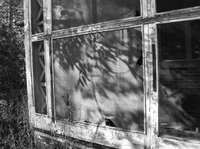 As the photos show, there are several old, deteriorating houses on the hospital grounds that once served as residences for nurses and doctors, now making perfect habitations for restless spirits.
As the photos show, there are several old, deteriorating houses on the hospital grounds that once served as residences for nurses and doctors, now making perfect habitations for restless spirits. The symposium I attended this week was organized to discuss strategies to improve efficiencies in knee and hip replacement surgery and rehabilitation. In Canada, we have a publicly funded health system that operates with dollar caps. This leads to waits for orthopedic, cardiac, ophthalmologic and even cancer surgery. The present demand for joint replacement surgery in the boomer generation is growing so quickly, that in five to seven years these procedures will potentially consume the total health budget of Ontario, so savings must be found. Each replacement costs between $10-12,000 CDN and patients sometimes have multiple joints surgeries. The average life of an artificial joint is ten years so more costly revisions are ahead for many people. The same situation exists in United States and other western nations.
The symposium I attended this week was organized to discuss strategies to improve efficiencies in knee and hip replacement surgery and rehabilitation. In Canada, we have a publicly funded health system that operates with dollar caps. This leads to waits for orthopedic, cardiac, ophthalmologic and even cancer surgery. The present demand for joint replacement surgery in the boomer generation is growing so quickly, that in five to seven years these procedures will potentially consume the total health budget of Ontario, so savings must be found. Each replacement costs between $10-12,000 CDN and patients sometimes have multiple joints surgeries. The average life of an artificial joint is ten years so more costly revisions are ahead for many people. The same situation exists in United States and other western nations. 





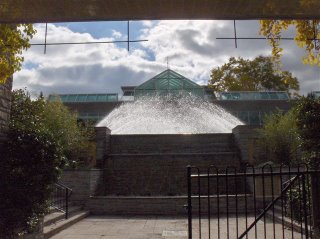
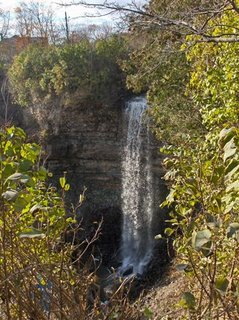





 The parallel bars in the therapy room at the hospital are used frequently in gait training for our patients. No one in our program practices ballet demi-plies or pirouettes in the bars. Instead, legs with grinding joints, weakened muscles and heavy feet, are dragged along with the support of the arms and one or two assistants. Many patients get stronger and are able to walk out of the room with a walker or cane, while others end up in wheelchairs indefinitely.
The parallel bars in the therapy room at the hospital are used frequently in gait training for our patients. No one in our program practices ballet demi-plies or pirouettes in the bars. Instead, legs with grinding joints, weakened muscles and heavy feet, are dragged along with the support of the arms and one or two assistants. Many patients get stronger and are able to walk out of the room with a walker or cane, while others end up in wheelchairs indefinitely.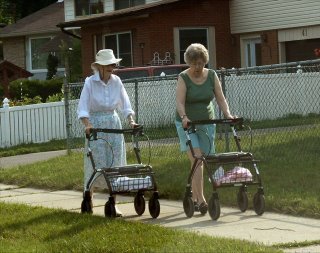
 We have had incessant rainfall for the past few days making this one of the wettest fall seasons I can remember. The family of one of my coworkers have a farm about 60 km from here. Their corn is starting to get moldy in the fields as the ground is too wet to support the harvesting machines. Her father has been cutting some of the corn by hand, and they are concerned about the quality of the feed for their livestock.
We have had incessant rainfall for the past few days making this one of the wettest fall seasons I can remember. The family of one of my coworkers have a farm about 60 km from here. Their corn is starting to get moldy in the fields as the ground is too wet to support the harvesting machines. Her father has been cutting some of the corn by hand, and they are concerned about the quality of the feed for their livestock. On the positive side, some vegetables have flourished in this wet season. At the market yesterday, there were some of the largest cauliflowers I had ever seen! The farmer told me they were extra large because of all moisture they had received this year. I already had a supermarket cauliflower at home,
On the positive side, some vegetables have flourished in this wet season. At the market yesterday, there were some of the largest cauliflowers I had ever seen! The farmer told me they were extra large because of all moisture they had received this year. I already had a supermarket cauliflower at home, 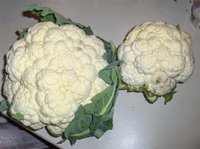 but could not resist getting a “monster head” as well. The smaller cauliflower is now in soup, and we will be eating a lot more of this vegetable throughout the week.
but could not resist getting a “monster head” as well. The smaller cauliflower is now in soup, and we will be eating a lot more of this vegetable throughout the week.
 In roadside stands such as the one pictured here, small chunks of sugar cane, marinated in salt and lime juice, are sold in plastic bags. When we climbed the Ceboruco volcano, I found the juicy, sweet and salty canes a fibrous but refreshing snack, although they eventually gave me a sore mouth.
In roadside stands such as the one pictured here, small chunks of sugar cane, marinated in salt and lime juice, are sold in plastic bags. When we climbed the Ceboruco volcano, I found the juicy, sweet and salty canes a fibrous but refreshing snack, although they eventually gave me a sore mouth. which were grated or broken in chunks with tongs. It would be difficult to over indulge in sugar when it took so much work to use it.
which were grated or broken in chunks with tongs. It would be difficult to over indulge in sugar when it took so much work to use it.  This fair trade sugar I bought cost triple the amount of regular sugar. I use it sparingly and thoughtfully and hope that the people involved in production received a fair wage for their efforts.
This fair trade sugar I bought cost triple the amount of regular sugar. I use it sparingly and thoughtfully and hope that the people involved in production received a fair wage for their efforts. I have seen a number of patients with tattooed numbers on their forearms, engraved during their time spent in concentration camps during World War II. Our community has strong German roots and we also have many people here from Eastern Europe who immigrated following the war. The stories they tell defy imagination and many of them carry emotional scars to this day.
I have seen a number of patients with tattooed numbers on their forearms, engraved during their time spent in concentration camps during World War II. Our community has strong German roots and we also have many people here from Eastern Europe who immigrated following the war. The stories they tell defy imagination and many of them carry emotional scars to this day. I later found out that my good friend, who is an English professor at York University, has added the two books to her curriculum. I sat down one evening, very tired, and decided to read only a few pages of the first volume. I could not put it down and finished “My Father Bleeds History’ in one sitting. Art Spiegelman brilliantly tells two stories; one of his father’s war experiences and the other of his relationship with the old, sick, cantankerous man. The families of the survivors live with the psychological fallout from their war experiences through subsequent generations.
I later found out that my good friend, who is an English professor at York University, has added the two books to her curriculum. I sat down one evening, very tired, and decided to read only a few pages of the first volume. I could not put it down and finished “My Father Bleeds History’ in one sitting. Art Spiegelman brilliantly tells two stories; one of his father’s war experiences and the other of his relationship with the old, sick, cantankerous man. The families of the survivors live with the psychological fallout from their war experiences through subsequent generations. The weather has warmed up considerably since the weekend, so I went out to my garden to assess the damage from the first light freeze. I have very few annuals, but had to remove the soggy stems of the fragile and frozen impatiens plants from the pots on the deck. The geraniums have survived thus far. The weight of the snow flattened the peony foliage and the large leaves of the rhubarb plants had collapsed under the heavy ice. The ferns have retreated to the soil and the hosta leaves are yellowed and rotting. I popped the last of the frozen raspberries in my mouth. But much remains, and I hope that I will be harvesting from the garden until December.
The weather has warmed up considerably since the weekend, so I went out to my garden to assess the damage from the first light freeze. I have very few annuals, but had to remove the soggy stems of the fragile and frozen impatiens plants from the pots on the deck. The geraniums have survived thus far. The weight of the snow flattened the peony foliage and the large leaves of the rhubarb plants had collapsed under the heavy ice. The ferns have retreated to the soil and the hosta leaves are yellowed and rotting. I popped the last of the frozen raspberries in my mouth. But much remains, and I hope that I will be harvesting from the garden until December. Arugula, planted in late July, has never tasted better as it grows in an old car tire. I love mixing the peppery leaves in with other greens, or steaming them lightly with some pasta.
Arugula, planted in late July, has never tasted better as it grows in an old car tire. I love mixing the peppery leaves in with other greens, or steaming them lightly with some pasta. 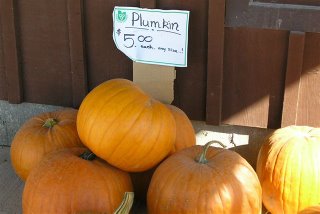 I took the picture of this sign at the farm where we buy our apples. I have no idea who created the misspelled sign, but we had a good chuckle when we saw it. I have been acutely aware of my weaknesses in spelling and grammar since starting this blog. I labour over phrases and spelling, aware that readers may find an error as glaring as the one on the sign. In Canada we use a mixture of British and American spelling, for instance colour and labour, rather than color and labor. But we use the American spelling of pediatric rather than the British paediatric. I have been told that learning a language such as Spanish is much easier than learning English, as there are fewer grammatical and spelling irregularities. Both my brothers who live in Mexico have schools where English is taught as a second language. I sat through one class earlier this year while the students conjugated verbs in the past tense (ugh!) and practiced a vocabulary list.
I took the picture of this sign at the farm where we buy our apples. I have no idea who created the misspelled sign, but we had a good chuckle when we saw it. I have been acutely aware of my weaknesses in spelling and grammar since starting this blog. I labour over phrases and spelling, aware that readers may find an error as glaring as the one on the sign. In Canada we use a mixture of British and American spelling, for instance colour and labour, rather than color and labor. But we use the American spelling of pediatric rather than the British paediatric. I have been told that learning a language such as Spanish is much easier than learning English, as there are fewer grammatical and spelling irregularities. Both my brothers who live in Mexico have schools where English is taught as a second language. I sat through one class earlier this year while the students conjugated verbs in the past tense (ugh!) and practiced a vocabulary list.  I conjugated French verbs and memorized many vocabulary lists for 7 years in school and cannot carry on a conversation in Canada’s other official language.
I conjugated French verbs and memorized many vocabulary lists for 7 years in school and cannot carry on a conversation in Canada’s other official language. One of the first blogs I read was Fat Doctor through a link on Medscape. I was intrigued by her story and followed it sporadically for a few months. My daughter then began corresponding with cousins and friends on MySpace and I got a better idea of the interactive quality of blogs. However, MySpace was not for me and I decided to try a Blogger account. For the most part, it has been quick and easy to use.
One of the first blogs I read was Fat Doctor through a link on Medscape. I was intrigued by her story and followed it sporadically for a few months. My daughter then began corresponding with cousins and friends on MySpace and I got a better idea of the interactive quality of blogs. However, MySpace was not for me and I decided to try a Blogger account. For the most part, it has been quick and easy to use. I thought I would write about physiotherapy, perhaps giving some tips and advice, and about the experiences I have with my patients in my workplace.
I thought I would write about physiotherapy, perhaps giving some tips and advice, and about the experiences I have with my patients in my workplace. I am more observant of little things each day as I carry my camera and ideas around with me. People inspire me. I love listening to their stories and watching the ways in which they face their challenges. I enjoy travel and nature and draw on recent observations and previous personal experiences. I have learned new things about my own family as members email facts and stories in response to certain posts. I look forward to new inspiration and ideas, interaction with old and new friends, in this blog and others.
I am more observant of little things each day as I carry my camera and ideas around with me. People inspire me. I love listening to their stories and watching the ways in which they face their challenges. I enjoy travel and nature and draw on recent observations and previous personal experiences. I have learned new things about my own family as members email facts and stories in response to certain posts. I look forward to new inspiration and ideas, interaction with old and new friends, in this blog and others.  Motorcycles and Friday the 13th
Motorcycles and Friday the 13th
 Winter left a calling card today...
Winter left a calling card today... Where is the ice scraper for the car? I have to be ready to leave for work earlier in anticipation of icy roads and unprepared drivers.
Where is the ice scraper for the car? I have to be ready to leave for work earlier in anticipation of icy roads and unprepared drivers. Reflection on the year 1948
Reflection on the year 1948
 Family Ties
Family Ties Cranberries
Cranberries Postcards for Thanksgiving Weekend
Postcards for Thanksgiving Weekend 
 This is one of two buildings where indoor vendors are open year round. The other building has a livestock auction and flea market.
This is one of two buildings where indoor vendors are open year round. The other building has a livestock auction and flea market.



